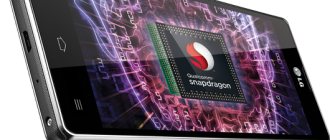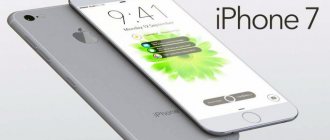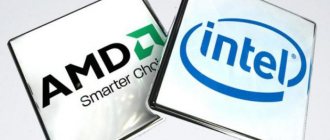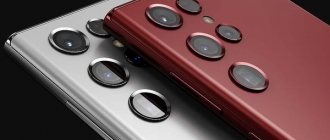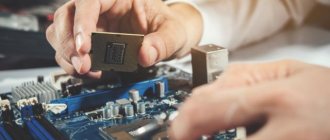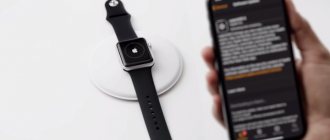I don’t think that the technical specifications for the development of the next mobile system-on-a-chip included a requirement to beat multi-core competitors in benchmarks. The main goal was still the same: to make the next smart phone and tablet the best in the world. We wanted the best, it turned out as always. Formally, the new A-chip used a 4-core processor. And amazing stories about 2-core processors superior to 6-, 8- and even 10-core competitors' CPUs seem to be a thing of the past. But the world is more complicated than it seems.
Losing is unpleasant, especially if the prize fund is billions of dollars, while there are still millions of mobile adventurers in the accounts. And those who lose often behave unworthily. They claim that everything is a set-up. That by creating a processor for one or two specific devices it is not difficult to achieve killer advantages (and who forbade them to do the same if it was not difficult?)
“Victory gives birth to hatred, the defeated lives in sorrow,” an unknown author wrote in the sacred book of Buddhists back in the 6th century BC.
And he offered a solution: just give up the fight, both victory and defeat at once - and you will be happy.
Apple was accused of being old-fashioned, of not using fashionable, progressive technologies, or of starting to use them when they are about to become obsolete. It's a strange company: it produces beautifully designed junk, it's expensive, it decides for those who spend money what and in what form they should buy - and is a leader in the industry. Magic?
In the Middle Ages, Apple's leadership would have simply been burned long ago.
The processor in the Apple A10 Fusion, being a 4-core one, behaved like a 2-core one in tests and in real life. And it still left behind 6- and 8-core rivals. And the disgustingly pleased Phil Schiller limited himself, as always, to a minimum of information.
And the architecture used in the Apple A10 Fusion was destined to remain the peak of fashion for less than a year. ARM Holdings introduced the big.LITTLE architecture in October 2011. In October 2012, ARM announced the first practical implementation of these ideas. At the end of 2013 big.LITTLE became a reality. In 2016, it was “old news,” the technology had fermented and matured—and now magicians from central California took notice.
Or, rather, they considered it appropriate to use it for their own purposes. Be that as it may, the Apple A10 Fusion replaced the Apple A9, a system-on-a-chip still present in the top but pushed out of the top places, and Apple again found itself in the lead.
And six months after the release of the Apple A10 Fusion, in May 2022, ARM introduced the successor to big.LITTLE, the DynamIQ architecture.
This is a continuation of the series about processors from Apple. Previous parts:
First part: In the shadow of Apple A4; Part two: The birth of the “Apple” processor; Third part: Returning to the beginning: Apple A6/A6X (Swift); Part four: Cyclone replaces Swift (in Apple A7); Fifth part: Another “NeXT”, or fitness coprocessor (Apple M7); Sixth part: Cyclone turns into Typhoon (Apple A8); Part seven: Apple S1: a mystery wrapped in a secret; Eighth part: Apple A8X: Graphics in the area of special attention; Ninth part: Apple A9 – a deceiver, a scoundrel and a chipgate; Tenth part: Apple A9X: Nuclear physics?.
About the processor
As Apple's first quad-core SoC, it features two high-performance cores designed for demanding tasks such as gaming, as well as two power-efficient 64-bit Apple cores codenamed Zephyr for general tasks in a configuration similar to ARM's big.LITTLE technologies. The postscript “Fusion” says just that.
However, unlike most big.LITTLE implementations, such as the Snapdragon 820 or Exynos 8890, only one type of core can be active at a time, either high-power or low-power cores, but not both. Thus, the A10 Fusion appears to be a dual-core chip by software and benchmarks.
Apple claims that the high-performance cores are 40% faster than the previous Apple A9 processor, and that the two high-performance cores consume 20% of the power of the Hurricane's high-performance cores, used when performing simple tasks such as checking email. The new performance controller decides in real time which pair of cores should run on a given task to optimize performance or battery life.
The new 6-core GPU built into the A10 chip is 50% faster while consuming 66% of the power of its predecessor A9. The A10 has an M10 motion coprocessor built into it. The chip also includes a new image processor, which Apple says has twice the bandwidth of the previous image processor. A10 Fusion adds hardware encoding for HEIF and HEVC.
Antutu rating
Apple A10 Fusion scores about 225,000 points in the Antutu rating. For comparison, the A9 scores approximately 175,000 conventional units on average.
Main features of A10
- Increasing the number of physical cores by two.
- Preservation of the old 16-nanometer production process.
- Larger crystal size of A10 compared to .
Photo: Comparison of Apple A10 characteristics and parameters of other microprocessors.
The refusal to move to 14 nanometers was most likely due to large production volumes, which would have been too complicated by the transition to a more recent technology. However, maintaining the established production scheme allowed the company to devote more time to optimization, both of finished products and of the chip itself and its architecture.
Specifications
CPU
Base frequency – 2x 2.39 GHz (Hurricane) + 2x 1.1 GHz (Zephy) Number of cores – 4
GPU
Accelerator model – PowerVR Series 7XT GT7600 Plus 650 MHz Number of cores – 6
RAM
Type of RAM – LP-DDR4 1600 MHz Amount of RAM – 2 GB
Other
Technological process – 16 nm Number of transistors – 3.3 billion Instruction set – ARMv8-A Crystal area – 125 mm^2 Bluetooth version – 4.2 Wi-Fi version – 5 5G support – no
Performance A10
This is where Apple made a big leap forward compared to the A9. The 40% jump in performance compared to its predecessor is amazing.
Of course, this was achieved largely by adding two more physical processor cores, but the improved architecture, as well as higher frequencies (a quarter higher than its predecessor) made a significant contribution.
By the way, a significant increase in core frequency (up to 2.33 gigahertz) with the same technical process became possible due to an increase in the voltage on the chip and an improved heat dissipation system.
Devices running on Apple A10
- iPhone 7 - since September 2016
- iPhone 7 Plus - since September 2016 - 3 GB
- iPad 2018 - from March 2022
- iPad 2019 - from September 2022 - 3 GB
- iPod Touch 7th generation - from May 2022 - artificially lowered to 1.64 GHz
—> Next Apple A11 chip —> —> Improved Apple A10X chip —> <— Previous Apple A9 and Apple A9X chips <—
All Apple A-series chips
Where to repair Macbook, iMac and iPhone
Checklist for choosing a reliable service center for repairing Apple equipment
Prices
Fair, not overpriced and not underestimated. There should be prices on the Service website. Necessarily! without asterisks, clear and detailed, where technically possible - as accurate and conclusive as possible.
Deadlines
If spare parts are available, up to 85% of complex repairs can be completed in 1-2 days. Modular repairs require much less time. The website shows the approximate duration of any repair.
Warranty and responsibility
A guarantee must be given for any repairs. Everything is described on the website and in the documents. The guarantee is self-confidence and respect for you. A 3-6 month warranty is good and sufficient. It is needed to check quality and hidden defects that cannot be detected immediately. You see honest and realistic terms (not 3 years), you can be sure that they will help you.
Stock
Half the success in Apple repair is the quality and reliability of spare parts, so a good service works with suppliers directly, there are always several reliable channels and your own warehouse with proven spare parts for current models, so you don’t have to waste extra time.
Free diagnostics
This is very important and has already become a rule of good manners for the service center. Diagnostics is the most difficult and important part of the repair, but you don't have to pay a penny for it, even if you don't repair the device based on its results.
Service repairs and delivery
A good service values your time, so it offers free delivery. And for the same reason, repairs are carried out only in the workshop of a service center: they can be done correctly and according to technology only in a prepared place.
Convenient schedule
If the Service works for you, and not for itself, then it is always open! absolutely. The schedule should be convenient to fit in before and after work. Good service works on weekends and holidays. We are waiting for you and working on your devices every day: 9:00 - 21:00
The reputation of professionals consists of several points
Company age and experience
Reliable and experienced service has been known for a long time. If a company has been on the market for many years and has managed to establish itself as an expert, people turn to it, write about it, and recommend it. We know what we are talking about, since 98% of incoming devices in the service center are restored. Other service centers trust us and refer complex cases to us.
How many masters in areas
If there are always several engineers waiting for you for each type of equipment, you can be sure: 1. there will be no queue (or it will be minimal) - your device will be taken care of right away. 2. you give your Macbook for repair to an expert in the field of Mac repairs. He knows all the secrets of these devices
Technical literacy
If you ask a question, a specialist should answer it as accurately as possible. So that you can imagine what exactly you need. They will try to solve the problem. In most cases, from the description you can understand what happened and how to fix the problem.
Openness of the service is the key to mutual trust and cooperation
Social media
If they are trying to organize a convenient service for you, you will definitely find the company on VK, Facebook, Instagram, and of course, on the Youtube channel. Here you can always, in an informal setting, look at the life of the service from the inside, evaluate examples of repairs, and communicate with specialists live. It’s convenient, and now you simply can’t live without social networks
Faces of the company
Apple's seasoned experts and engineers are superheroes, but they don't wear masks. On the website and on social networks you can always see who you are going to, see photos and learn a little about the engineers and service managers. You can write to each of them, suggest or clarify something with someone with whom you have already communicated.
Reviews
You can understand a lot from reviews if you treat them correctly. The overall assessment of the service should be positive and high. But the rating cannot be maximum. Reviews can be both positive and negative, the main thing is that they respond to them, communicate, make decisions, help, that is, treat them like a human being.
Ask a Question
Articles
- iPhone 11 and the new flagship iPhone 12: what are the differences between the models?
- Apple Pro Display XDR
- AirPods Pro
- Apple Watch Series 5
- New iPad 10.2″
- Review of the new Mac Pro
- Review of MacBook Pro 16″ A2141
- iPhone 11 Pro Max review
- iPhone 11 review
- Apple presentation September 2019
- Replacing glass on iPhone
- MacBook Pro 16 Rumors
- Apple News 2019
- The essence of the Apple 2018 presentation
- Apple 2018 presentation
- What Apple showed at WWDC
- What's new in macOS 10.14 Mojave
- Apple introduced iPad 2018
- iPhone 5c owners can expand storage capacity for free
- Expensive HomePod repairs
- A new Trojan has appeared on macOS
- What you need to know from Meltdown and Specter
- iMac Pro will receive an A10 coprocessor
- Critical vulnerability in Mac OS High Sierra
- iPhone X is the most fragile smartphone
- iPhone X Unboxing
- Detailed specifications of iPhone X
- APFS for Fusion Drive will be supported in future macOS
- APFS will not support Fusion Drive
- New features and capabilities of iOS 11
- New iPhones at the Apple 2017 presentation
- iPhone 8 - what's inside?
- Features of sound notifications in iPhone 8
- What familiar apps will look like on iPhone 8
- iPhone 8 – Apple presentation September 12, 2017
- iPhone 8 memory specifications
- iPhone 8 OLED display coming in 2022
- iPhone 8 USB-C
- Wireless charging for iPhone
- iPhone 8 will receive moisture protection and wireless charging
- iMac Pro
- New iPad Pro and HomePod
- MacOS High Sierra what's new
- iPhone 8 photo
- Mac OS 10.12.6 and iOS 10.3 3 what's new
- iOS 11 What's New - iOS 11 Features: Dock and Apps
- Virus on MacBook and iMac from Word macros
- macOS now supports Night Shift
- The updated MacBook Pro will receive Kaby Lake processors and 32 GB of memory
- Fruitfly virus in MacOS takes screenshots
- 5″ iPhone will get two vertical cameras
- Second generation Apple Pencil
- iPhone 8 may get face and gesture recognition
- New MacBook Pros have graphics problems
- Apple Patent Describes How Apple Pencil Works with iPhone
- HyperDrive - solution to the problem of missing MacBook Pro ports
- MacOS will no longer show remaining battery life
- Tim Cook confirms work on new iMac
- MacOS 10.12.2 increases the autonomy of the new MacBooks
- Third-party case adds wireless charging, extended battery, and headphone jack to iPhone 7
- Why Apple stopped updating Mac
- How to set up Touch ID and view your purchase history on MacBook Pro
- Next year we will see iPhone 7s instead of iPhone 8, information about the new device
- iPhone camera will get augmented reality mode
- What's new in iOS 10
- How to take screenshots using the Touch Bar
- At the end of 2016, Apple will stop supporting devices from 2009 to 2011.
- When will third-party apps start supporting Touch Bar?
- The frameless iPad will retain the form factor of its predecessor and will lose the Home button
- 15- MacBook Pro has a non-removable SSD
- In the future, you will be able to track even a turned off iPhone
- iPhone 7 battery lasts longer than competitors
- New MacBook Pros are not compatible with some Thunderbolt devices
- Is it possible to charge an iPhone using a more powerful charger?
- A third-party strap will add two cameras to the Apple Watch
- iOS and backup
- Ports on the right side of the new MacBook Pros are slower
- How the T1 chip works in the Touch Bar and why it is needed
- Review of the new MacBook Pro
- Disassembly results: the new MacBook Pro is almost beyond repair
- Foxconn tests wireless charging for iPhone 8
- The new MacBook Pro has the fastest storage on the market
- New way to hack a locked iPhone
- How Touch Bar works in Windows
- Results of the October Apple event
- Disassembly showed that the SSD on the new MacBook Pro is removable
- The new MacBook Air could get an A10 chip
- One-handed keyboard mode detected in iOS code
- Lettering may come off the back cover of the iPhone 7
- It turned out to be cheaper to maintain a Mac than a PC
- Intel will push Apple to update graphics in MacBook
- How fast does iPhone charge?
- Specifications MacBook Pro Retina 2016, Air 2016, iMac 2016
- Apple Presentation - October 2016
- Apple Watch will be able to distinguish the owner by the nature of the heartbeat
- 32-bit apps can slow down your iPhone
- Spotify Free may infect your Mac with a virus
- Some iPhone 7s were locked -out of the box-
- Top 8 Reasons to Upgrade to iPhone 7
- 7.9- iPad Pro -mini- coming in 2022
- Premium versions of iPhone 8 will have a stainless steel frame
- Apple Pay launched in Russia
- iPhone 8 will get an OLED display from Sharp
- Apple rejects almost half of Jet Black devices
- iPhone 7 camera review
- Which iPhone 7 should you choose?
- iPhone 7 may explode in box
- The iPhone 7 display turned out to be “the best LCD solution on the market”
- Some iPhone 7s are noisy under load
- First reviews of Apple Watch Series 2
- Full review of the Apple A10 chip
- The cost of the iPhone 7 was $220
- Apple's new battery case charges 26% better
- When you first start the iPhone 7, it prompts you to adjust the sensitivity of the Home button.
- iPhone 8 buttons will be built into the display
- Future iOS devices may get Intel processors
- OLED will only be a temporary solution for iPhone
- First impressions of the Apple Watch Series 2
- The 2022 iPad Pro will work better with the Apple Pencil
- First impressions of Apple AirPods
- iPhone 7 Plus was faster than iPad Pro
- Future 4.7 iPhones will not have a dual camera
- iPhone 8 will receive wireless charging
- New MacBook Pro and Air coming in October
- Tim Cook hinted at the imminent appearance of new Macs
- iPhone 7 Plus received 3 GB of memory
- What did the iPhone 7 become?
- iPhone will lose Home button in 2022
- First impressions of the iPhone 7
- Advanced Mac Cleaner installs a virus
- MacBook will receive an OLED touch panel and Touch ID
- Apple Pencil learns to work with Mac trackpad
- Users experienced difficulty logging into Apple ID on iOS
- Android launched on iPhone
- A photo of the top case of the new MacBook Pro has appeared on the Internet
- Thunderbolt Display will get its own graphics
- iPhone 8 may get a curved display
- What updates are coming to Mac this year?
- Apple received a new patent for placing Touch ID under the screen
- What you need to know about deleting system apps in iOS 10
- Apple patents a transparent iPhone
- Apple will release a premium iPhone with a curved screen
- How the Touch Bar will work on a MacBook
- Apple will update iPhone every three years
- Samsung's new flagship was slower than iPhone 6s
- Apple starts selling refurbished iPad Pros
- The new MacBook will receive a power button with a biometric scanner and a touchpad
- In the future, Apple plans a 10.5″ iPad Pro and a “revolutionary” iPad with an OLED display
- New Thunderbolt Display is in development
- Mac won't get Kaby Lake processors until 2022
- Apple presentation September 7, 2016 WWDC
- Optical stabilization in iPhone 7
- iPhone 7 will get 256 GB of memory
- iPhone 7 Plus will get a 2k display
- New iPhone 7 photos in high resolution
- The second speaker of the iPhone 7 may be “fake”
- iPhone 7 will charge faster
- Photos of a black iPhone 7 Plus with Smart Connector
- Comparison of iPhone 6s and iPhone 7
- iPhone 7 will get a touch-sensitive Home key with pressure recognition
- iPhone 7 sales start dates
- iPhone 7 will be available in 32, 128 and 256 GB versions
- Qualcomm's LTE will come to the Verizon version of the iPhone 7
- iPhone 7 may get LTE from Qualcomm or Intel
- New photos of iPhone 7 parts have leaked online
- iPhone 7 molds confirm absence of Smart Connector
- The network has photos of the camera and 256 GB of storage of the iPhone 7 Plus
- iPhone 7 promotional materials leaked online
- About the Production of iPhone 7
- iPhone 7 could have four speakers
- iPhone 7 Plus will receive a camera from LG
- Smart Keyboard received a Russian layout
- iPhone 7 Mockups Confirm Rumors About Plus and Pro Models
- The future MacBook Air will receive USB-C
- Images of an adapter from Lightning to 3.5 mm have surfaced on the Internet
- New iPhone 7 photos confirm larger camera
- Police vs biometric scanner
- 3 GB of RAM will be an exclusive feature of the iPhone 7 Plus
- Apple may open pre-orders for iPhone 7 as early as September 9
- Photo of iPhone 7 glass reveals dual sensors and longer speaker
- Fully functional Lightning EarPods shown in video
- Apple has closed the Jailbreak vulnerability in iOS 9
- iPhone will get an iris scanner
- iOS 10 lets you prioritize app downloads
- iPhone 7 Home button gets Force Touch
- iPhone 7 will come in a darker color
- iPhone 7 will get a longer earpiece
- MacOS Backdoor.MAC.Eleanor virus
- How to install macOS Sierra
- How to install iOS 10
- How to set up your Mac to automatically unlock
- New iPhone 7 renders leaked online
- What to expect when installing iOS 10 beta
- How to speed up Safari on iOS
- iPhone 7 will have a 1,960 mAh battery
- iOS 10 will reduce battery consumption
- iPhone 7 will lose the Mute key and get a Smart Connector
- iPhone 7 performance will be on par with iPad Pro
- More comprehensive Dark Mode found in Mac OS code
- Video of iPhone 7 case leaked online
- Apple is working on new headphones -AirPods-
- Software revolution: new items macos sierra, ios 10, watchos 3
- Comparison of iOS and Android devices: which breaks more often?
- Only iPhone 7 Plus will get dual camera and Smart Connector
- Apple won't split iPhone 7 into Plus and Pro
- What will the iPhone 8 design be like?
- Smart Cover with touch screen and solar panels
- TSMC is preparing 10 nm Apple A11
- iPhone 7 photos leaked online
- iPhone 7 won't get Smart Connector
- iPhone 7 will get rid of the shortcomings of the iPhone 6s
- Comparison of classic and Lightning headphones
- A technical render of the iPhone 7 has appeared online
- Leak: will the headphone jack remain in the iPhone 7
- Flexible Polymer Connectors for iPhone
- New ARM processors from Apple in MacBook 12
- iPhone 7 will get higher autonomy
- We'll see a flexible iPhone in the near future
- The speaker and Home button will disappear from the front of the iPhone
- Apple will reduce prices for its equipment in Russia
- What Apple will show at WWDC 2016
- Possible diagram of iPhone 7 Pro
- AMD Polaris graphics cards in the new Mac
- iPhone will receive 7nm A10 or A11 processor in 2022
- iPhone 7 and the touch Home button
- Apple Watch 2 with SIM card
- Analysis of the new MacBook Retina 2016 12″
- iPhone 7 will receive an LTE chip or SoC from Intel
- NAND Flash memory for iPhone 7 from Samsung
- Apple online Store app application for iOS
- Rumors about Mac OS 2016
- Advantages and disadvantages of iPad Pro 9.7”
- Apple's refusal of the MacBook Air
- New MacBook 12″ mid 2016
- Problems with Bluetooth on iPhone SE
- Rumors about Apple Watch 2
- 14nm and 16nm iMac GPUs
- Apple Pay may appear in Russia this year
- Magic Mouse with Force Touch
- Mac Pro will receive a 22-core Xeon E5
- Sign language on Apple Watch
- Everything you need to know about iPhone SE: advantages and disadvantages
- Analysis of iPad Pro 9.7”
- iPhone SE analysis
- Apple Pay in online payment
- Smart Connector and MagSafe for iPhone
- iPad Pro 9.7” is weaker than iPad Pro 12.9”
- AMOLED iPhone 2022 and glass in design
- MacBook 12″, 13″ and 15″ forecasts 2016
- MacBook Retina 12″ early 2016 on OS X Server
- Comparison of iPad Pro 12.9″ and 9.7″
- Apple will begin developing its own graphics
- Lightning headset for iPhone 7
- Apple Conference in March 2016 - Results
- Characteristics and photos of the iPhone 7 Battery
- Intel's new SSD will appear in the MacBook Pro Retina
- iPhone will get a 5.8″ OLED display
- Apple Watch can save your life
- Photos of cases and form factor iPhone 7
- Liquid metal in the new iPhone 7
- New panoramic photos in iPhone 7
- iPhone 5se body and iPhone 7 dual camera
- Memory capacity in iPhone 7 and iPhone SE
- Photos of the iPhone 7 appeared online
- New items from Apple's March presentation
- Beta 6 for OS X 10.11.4 and iOS 9.3
- About the iPhone 7 case and stereo speakers
- The new iPad 9.7″ takes better pictures than the iPad Pro
- Apple will add Siri to OS X 10.12
- iOS update will help solve touch id problem
- What will the iPhone 6c (iPhone 5e) be like?
- What will the iPhone 7 be like?
- Setting up iPhone 6 - JailBreak design
- iPhone interface customization
- What will the next iPhone be?
Question
Repair request
Press about us Reviews Vacancies Details Delivery and payment Cooperation Team
We repair:
- iPhone iPhone 4..5s
- iPhone 6
- iPhone 6s
- iPhone 6 Plus
- iPhone 6s Plus
- iPhone SE
- iPhone 7
- iPhone 7 Plus
- iPhone 8
- iPhone 8 Plus
- iPhone X
- iPhone XS
- iPhone XS Max
- iPhone XR
- iPhone 11
- iPhone 11 Pro
- iPhone 11 Pro Max
- iPhone 12
- iPhone 12 Pro
- iPhone 12 Pro Max
- iPhone 12 mini
- iPhone 13
- iPhone 13 Pro
- iPhone 13 Pro Max
- iPhone 13 Mini
- FAQ iPhone
- iPhone exchange
- iPad 6
- iMac
- MacBook
- Time Capsule
Processor iPhone 11 SE (2020)
The iPhone 11, as well as the iPhone 11 Pro, Pro Max and SE (2020), uses the 64-bit 6-core ARM Apple A13 Bionic processor, introduced in 2022.
| Specifications Apple A13 Bionic | |
| Cores, clock speeds | 2 high-performance Lightning cores @ 2660 MHz 4 low-cost Thunder cores @ 1600 MHz |
| Graphic arts | 4 graphics cores (with Metal 2 technology), 736 Gigaflops |
| Neuroprocessor | 8-core Neural Engine |
| Technical process | 7nm TSMC |
| Number of transistors | 8.5 billion |
| TDP | 6 W |
| Performance | |
| AnTuTu 8 | 477774 |
| GeekBench 5 | 1355 / 3565 |
Apple A11 how many cores and what performance
Apple has been developing all its processors independently for a long time. Yes, it takes ARM technologies and ARMv8-A instruction sets as a basis, but it determines the chip architecture and set of coprocessors itself, scrupulously adjusting the hardware features to the operating system tools and vice versa, adding software to the capabilities of a particular chip. That’s why Apple smartphones have historically higher performance both in tests and in real-life situations, despite the smaller number of cores and lower frequencies relative to competitors. Apple chips don’t need 10 cores and don’t need a core frequency of 3 GHz, they can beat everyone anyway!
The new Apple A11 chip introduced a number of new technologies that directly affected the performance of the processor and devices on it. Let's focus on three of them:
Apple A11 10nm process technology
A11 is made according to modern 10nm design standards. The production was handled by Taiwanese TSMC, just like last time. Before TSMC, Apple chips were assembled at Samsung microprocessor factories, but a switch occurred last year. The decision is political, since Samsung is Apple's main competitor in most markets. Thanks to the transition to a thinner technical process, the new Apple chip fits a record number of transistors - 4.3 billion! Last year's iPhone 7 installed the Apple A10 chip, so there are only 3.3 billion transistors: an increase of 30%! The number of transistors in competitive solutions (for example, Snapdragon 835) is not disclosed, so we can assume that there are actually fewer of them, otherwise Qualcom would not fail to show off his numbers.
Apple A11 - six-core
For the first time, an iPhone has a six-core processor! In June, new iPads were introduced with a six-core A10X chip, which allowed them to squeeze out an outrageous 236 thousand points from the Antutu test, and now a similar processor is used in the iPhone! Yes, the iPhone 8, the iPhone 8 Plus, and even the top-end iPhone X are all six-core! A significant step forward, which all competitors took a long time ago, and Tim Cook saved it for this moment. Moreover, the apple also has an 8-core and 10-core structure in reserve, that is, the company knows what to surprise in the next couple of years... But the important change is not in the banal increase in the number of cores, but in the transition to free distribution of the load on the cores and the ability to activate any number of them at any given time. That is, this is not the familiar big.LITTLE technology, in which the cores are divided into clusters and only one of the clusters can work at a time, but this is a completely different system for distributing the load across computing power, capable of lighting all 6 stones at the same time! To control the flows, a second-generation Apple-Designed performance controller developed by Apple is used; the overall performance promises to be simply sky-high, most likely even higher than that of the mentioned iPads. We will wait for 240-250 thousand. scores in the Antutu test, and there were already leaks with Geekbench results, where the iPhone 8 showed more than 9900 points in multi-core testing.
Apple A11 has its own GPU graphics coprocessor
This time Apple went further in customizing its chip and is now developing all its elements independently, including the graphics coprocessor. Previously, Apple was forced to use third-party graphics, choosing solutions from PowerVR and customizing it to its needs. In 2022, a dark day came for PowerVR: Apple abandoned their services by developing its own GPU, which is 30% faster than the PowerVR GT7X used in the Apple A10. If it works with the same level of performance as the graphics of the previous generation, it will spend half as much energy on it. The graphics chip has not yet acquired a big name, but it is known that it has only three cores and, apparently, the 10nm process technology is also used here, otherwise where would such impressive performance come from?
Processor iPhone XS, XR
The iPhone XS, as well as the iPhone XS Max and XR, uses Apple's 64-bit 6-core ARM A12 Bionic processor, introduced in 2022.
| Specifications Apple A12 Bionic | |
| Cores, clock speeds | 2 high-performance Vortex cores at 2490 MHz 4 economical Tempest cores at 1600 MHz |
| Graphic arts | 4 graphics cores (with Metal 2 technology), 560 Gigaflops |
| Neuroprocessor | 8-core Neural Engine |
| Technical process | 7nm TSMC |
| Number of transistors | 6.9 billion |
| TDP | 6 W |
| Performance | |
| AnTuTu 8 | 408752 |
| GeekBench 5 | 1129 / 2956 |
